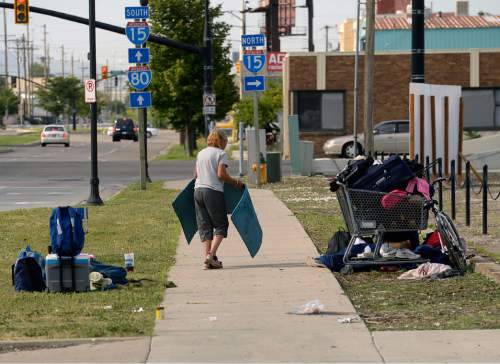This is an archived article that was published on sltrib.com in 2016, and information in the article may be outdated. It is provided only for personal research purposes and may not be reprinted.
The search is on in Salt Lake City for two sites that would accommodate homeless resource centers that would serve and house about 250 clients each.
Such site selections could be problematic if residents and property owners engage in stereotypes and NIMBYism, warned Mayor Jackie Biskupski Monday.
"We are setting an example for the rest of the state," she said. "We have buy-in for these ideas. Now it's time to implement them."
Her comments came as former Mayor Palmer DePaulis and Utah Jazz owner Gail Miller reconvened the Homeless Services Site Evaluation Commission.
In 2015, the commission, working with Salt Lake County's Collective Impact Committee, arrived at a new model to serve homeless people. It outlines a strategy to house and provide resources for sub-groups within the homeless population, such as families, people with addictions and those who have mental-health challenges, among others. Ideally, men and women would be housed in separate facilities.
The centers would be decentralized in an effort to take pressure off the community around Rio Grande Street downtown, the site of The Road Home shelter.
The city and county and other proponents sought $27 million from the Utah Legislature earlier this year. Rep. Francis Gibson, R-Mapleton, determined that would be too much to request in one session. His proposal, HB436, sought about one-third of that.
The Legislature approved $9.2 million and the governor approved the funding. Of that sum, $4.7 million will go to new facilities and $4.5 million will go to services.
Proponents hope lawmakers will appropriate equivalent funds in the next two legislative sessions.
When seeking new shelter sites, the commission will focus on criteria for such resource centers, DePaulis said.
Among those criteria are that shelters be integrated into surrounding areas, include outdoor gathering space, and be close to public transportation and schools.
It has been recognized that the current system is not sufficient, DePaulis said.
"We were missing the opportunity to serve those individuals in the way they need to be served," he said. "The idea is we could truly reach out and effect change."
Recently, the newly constructed shelter in Midvale was identified as the shelter for families. In June, the Volunteers of America will open its shelter for homeless youth.
"We are optimistic and we have momentum," DePaulis said. "We want to move this forward this year."



